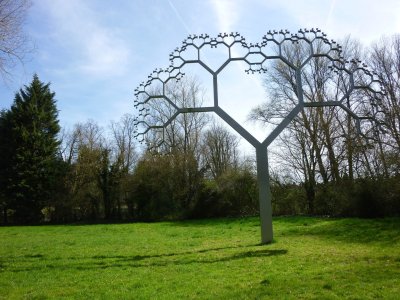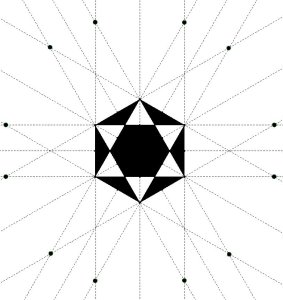Oxford Mathematician Dan Ciubotaru talks about his recent research in Representation Theory.
"The most basic mathematical structure that describes the symmetries that appear in nature is a group. For example, take all the permutations of the set $\{1,2,3,4\}$ (there are $24$ of them). Each permutation has an inverse one and if you compose two permutations you get another permutation etc. They form the symmetric group $S_4$. On the other hand, you can look at all the rotational symmetries of a cube in $3$-dimensions. There are again $24$ symmetries (this is less obvious) and they interact in the same way as before; in other words, it's the same group $S_4$.
Lie groups, named after the Norwegian mathematician Sophus Lie, are the mathematical objects underlying continuous (in fact, "differentiable'') symmetries inherent in various systems. Examples of Lie groups are the orthogonal groups, e.g., the symmetries of a circle or of a sphere; unlike the $S_4$ example, these are infinite groups. Originally, they appeared in mathematics as groups of symmetries of systems of differential equations, the idea being that by understanding the ways in which these groups act, namely their representations, one can gain some insight into what the space of solutions looks like.
Unitary representations are group actions on Hilbert spaces, at a first approximation, group actions that preserve lengths. The original motivation for their study comes from abstract harmonic analysis (Gelfand's programme) and from quantum mechanics (Wigner's work on the unitary representations of the Lorentz group). Abstract harmonic analysis can be viewed as a vast generalisation of Fourier analysis. In this interpretation, classical Fourier series corresponds to the action of the circle group $S^1$ (the symmetries of the circle) on the space of periodic square integrable functions $L^2(S^1)$. In representation theory, we want to understand the way in which such function spaces decompose into "atoms'' called irreducible representations. This is, as David Vogan from M.I.T. once said, "much as one may study architecture by studying bricks''.
My current research is concerned with understanding unitary representations of reductive $p$-adic groups. A typical example of reductive $p$-adic group is the group of $2$ by $2$ invertible matrices with coefficients in $p$-adic numbers (rather than real numbers). It is harder to explain the occurrence of this group as the symmetries of an object, but it is related to the symmetries of "trees''. To picture what a mathematical tree is, think of the famous sculpture "Y" at Magdalen College (pictured above), except imagine that the tree expands infinitely in all directions. The interest in studying the representations of these groups comes from modern number theory and the theory of automorphic forms. But while this appears to be far removed from 'real life', this theory turned out to have surprising concrete applications: possibly the first interesting construction of a family of expanders, which are certain types of graphs with high connectivity properties very important in computer science, came from this theory.
For these groups, the irreducible representations are almost all infinite dimensional. (Contrast this to the case of $L^2(S^1)$, where the irreducible representations are all one dimensional.) A long-standing conjecture in the field (due to Armand Borel about 1975) essentially asked if one can decide whether or not an infinite-dimensional representation is unitary only by looking at an appropriate finite-dimensional subspace. In a new paper (to appear in Inventiones Mathematicae 2018), I prove this conjecture in general. The new idea is to extend a notion of signature character introduced by Vogan for real reductive groups (and used for $p$-adic groups in an important particular case by Barbasch and Moy) with a "rigid'' density theorem. This latter ingredient stems from joint papers with He (e.g., Journal of the European Mathematical Society 2017), where we are trying to understand the interplay between character theory and a certain natural algebraic object (the cocenter).
For applications to automorphic forms, it is important to have quantitative results about the shape of the "unitary dual'', the set of irreducible unitary representations (together with some natural topological structure). A famous classical result in this direction is Kazhdan's "Property T'' which asserts that the trivial representation (the only one-dimensional representation that all of these groups have) is isolated in the unitary dual. In the second image above, this corresponds to the isolated dots. But for finer applications, one needs to know how isolated is this representation. This is called a "spectral gap.'' It turns out that a very useful tool for determining spectral gaps comes from Dirac operators in representation theory. For real Lie groups, this theory has a distinguished history with many highlights (works of Parthasarathy, Kostant, Atiyah and Schmid, Wallach, Vogan, Huang and Pandzic). For $p$-adic groups, only relatively recently this tool became available when we introduced it in joint work with Barbasch and Trapa (Acta Mathematica 2012) and with Opdam and Trapa (Journal Math. Jussieu 2014). As an application of these ideas, we show in particular that the spectral gap is precisely related to the geometric structure of the nilpotent cone in semisimple Lie algebras. I am currently continuing the research in the applications of the algebraic Dirac operators to representation theory with Marcelo De Martino, a postdoctoral fellow in Oxford, and with my DPhil student Kieran Calvert."
This research is supported by an EPSRC grant. For more on the subject see Dan's webpage.



